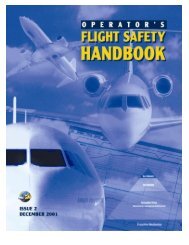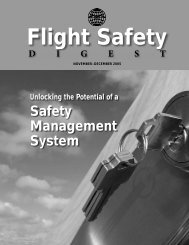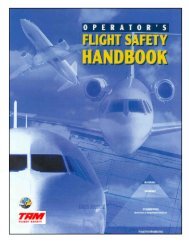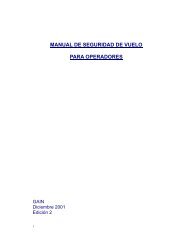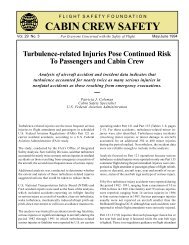Download PDF [10.9 MB] - Flight Safety Foundation
Download PDF [10.9 MB] - Flight Safety Foundation
Download PDF [10.9 MB] - Flight Safety Foundation
Create successful ePaper yourself
Turn your PDF publications into a flip-book with our unique Google optimized e-Paper software.
INFOSCAN<br />
The implication is<br />
that the captain is<br />
conscious and capable<br />
of communicating,<br />
but speaking or<br />
acting irrationally,<br />
endangering<br />
the flight.<br />
as ‘far more intelligent than the procedures.’<br />
Pilots are considered ‘better’ than the procedure<br />
because they have a certain amount of<br />
autonomy in their decisions, especially in case<br />
of abnormal situations and emergencies (even<br />
if, in some airlines, they have to justify that<br />
decision afterwards).”<br />
How far the experience and expertise of a pilot<br />
should be allowed free exercise is a question<br />
that seems to have no absolute answer, because<br />
there is no way to take account in advance of<br />
the pilot’s ability to fully know and understand<br />
the situation, the pilot’s state of mind, the pilot’s<br />
judgment abilities, the time pressure, and other<br />
variables. “There have been long discussions<br />
in many airlines and in international committees<br />
to decide if the first officer should take a<br />
decision/action in contradiction to the captain,”<br />
such as calling for a rejected takeoff or taking<br />
control of the aircraft, Pélegrin says.<br />
Organizations are caught between encouraging<br />
individual responsibility and defining<br />
its limits. “If an airline promotes the idea that<br />
everyone should be engaged in safety, then there<br />
should be consistent policies (including training,<br />
procedures and practices),” Pélegrin says.<br />
“For example, you cannot promote the idea that<br />
everyone must play a role in safety and not allow<br />
them to act in safety situations.”<br />
But when an organization orders a pilot to<br />
take extraordinary action under some circumstances,<br />
the long arm of the law reaches<br />
into the cockpit. Pélegrin says, “The Indian<br />
aviation authority has established a new rule:<br />
the copilot needs to shout two warnings to the<br />
commander if the aircraft is in danger during<br />
its approach to the runway. If the commander<br />
doesn’t listen, then the copilot has to<br />
take charge of all operational functions. The<br />
circular 2 noted the new actions would happen<br />
‘only in case of total or subtle incapacitation’ of<br />
the commander and also ‘those actions must<br />
be inducted from about 500 ft.’”<br />
It would be hard to find a better example of<br />
trying to have it both ways, mixing judgment<br />
and initiative with proceduralization.<br />
There have been too many accidents in<br />
which the captain appeared to have lost situational<br />
awareness and the first officer failed to<br />
compensate. Such accidents continue (ASW,<br />
3/13, p. 16). But consider the copilot’s dilemma,<br />
despite acting under a rule that intends to make<br />
his or her position clear.<br />
According to the author’s description, the<br />
rule applies only on approach. What if the<br />
wrong heading has been entered for the initial<br />
climb, a mountain ridge lies ahead, the TAWS is<br />
warning of the collision course with terrain and<br />
the captain appears oblivious to the risk. Is the<br />
copilot authorized to take charge?<br />
But that is only the first decision the copilot<br />
must make. He or she is to shout two warnings<br />
to the captain. How should they be phrased,<br />
what balance struck between respect for the<br />
captain’s rank and the second-in-command’s<br />
assumed right to avoid an impending accident?<br />
How much time needs to be granted for the<br />
captain’s response?<br />
First, the rule says that “if the captain<br />
doesn’t listen,” the copilot must take charge.<br />
That is unambiguous. But the rule also says<br />
the action is to happen “only in case of total<br />
or subtle incapacitation.” Total incapacitation,<br />
likewise, is clear and hardly needs to be embedded<br />
in regulation — any copilot in his proper<br />
mind would take over if the captain were<br />
suffering a medical emergency and completely<br />
unable to continue command.<br />
What is subtle incapacitation? The implication<br />
is that the captain is conscious and capable<br />
of communicating, but speaking or acting<br />
irrationally, endangering the flight. To put it<br />
paradoxically, how overt must “subtle” be? This<br />
theme was central to the classic novel of World<br />
War II, The Caine Mutiny, in which the ship’s<br />
officers had to decide what to do about the<br />
behavior of Capt. Queeg, a crackpot whose eccentricities<br />
might or might not have exceeded a<br />
captain’s authority.<br />
And what is the copilot to make of “these actions<br />
must [emphasis added] be inducted from<br />
about 500 ft”?<br />
50 | FLIGHT SAFETY FOUNDATION | AEROSAFETYWORLD | MAY 2013


![Download PDF [10.9 MB] - Flight Safety Foundation](https://img.yumpu.com/18550968/52/500x640/download-pdf-109-mb-flight-safety-foundation.jpg)

![Download this Issue [PDF 7 MB] - Flight Safety Foundation](https://img.yumpu.com/18859635/1/190x245/download-this-issue-pdf-7-mb-flight-safety-foundation.jpg?quality=85)
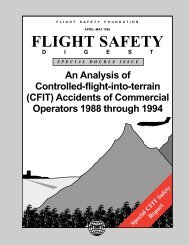
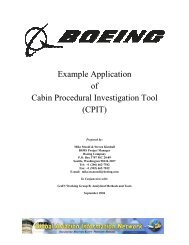
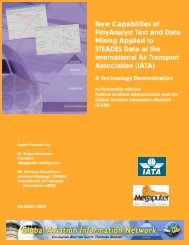
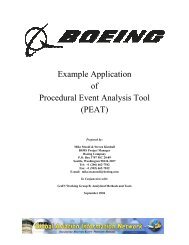
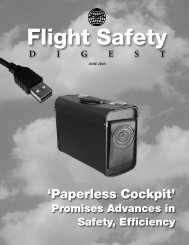
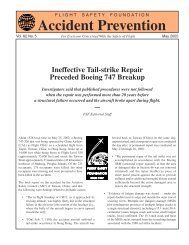
![Download [PDF 8 MB] - Flight Safety Foundation](https://img.yumpu.com/18859366/1/190x245/download-pdf-8-mb-flight-safety-foundation.jpg?quality=85)
